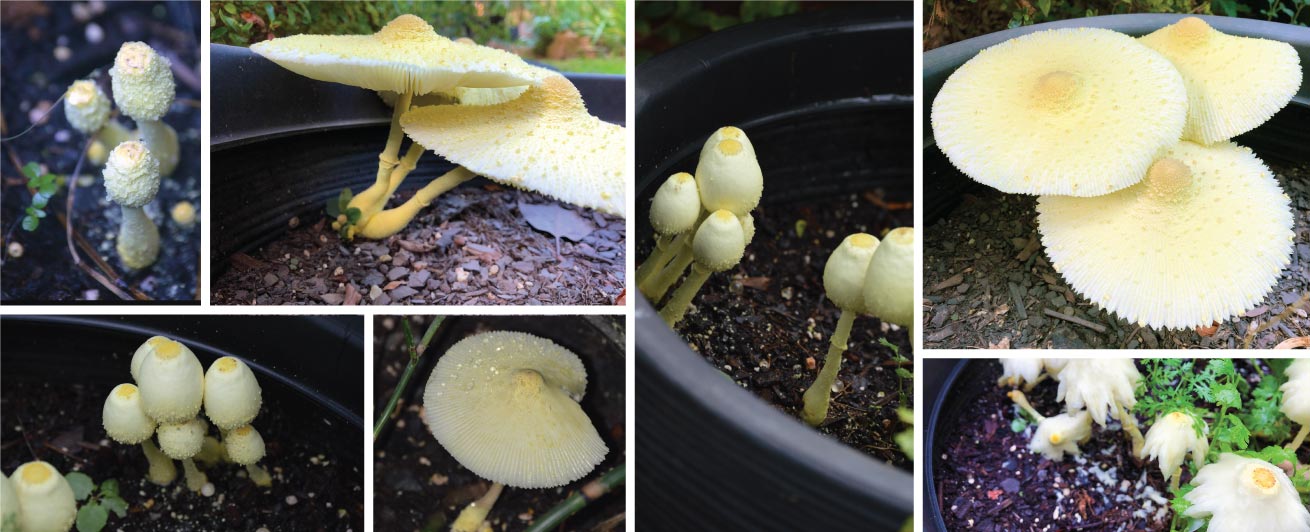Have you ever seen a yellow fungus growing from the soil of one of your potted plants? You might be surprised to know that these yellow mushrooms aren’t uncommon. They won’t hurt your plant and they aren’t harmful to you. They’re just a small part of the ecosystem doing their job in a pot of soil that happens to be in your house (or in my case, in a plant on the front porch).

The yellow houseplant mushroom (Leucocoprinus birnbaumii) is a yellow to white fungus often seen growing in potting soil used in houseplants. It starts out as a bright or pale yellow fuzzy patch on top of the soil and then develops into large parasol-shaped mushrooms. The fungus likely came in with the potting soil you purchased form the store. It isn’t harmful to you (unless you eat it) but it is nearly impossible to remove from the soil.
Where Did the Yellow Mushroom Come From?
The yellow houseplant mushroom (Leucocoprinus birnbaumii) probably came in the potting soil you bought for your plant. Mushrooms produce spores which are tiny, often microscopic “seeds” that can then create new fungus.
These spores can remain in the soil or surface for a long time before growing. So, the spores of this mushroom, also known as the flowerpot parasol or yellow parasol, may have been in the soil long before they produced mushrooms or grew into mycelia (the root-like or thread-like parts of a fungus that is usually found below the soil’s surface).
In my houseplants, this yellow mushroom begins to grow when I overwater, or when it’s an outdoor potted plant, it grows when the weather is really humid and rainy. I’m really bad about watering my houseplants – it’s either rainforest or desert for these guys.

Is it Harmful?
I know mushrooms make some people nervous. They’re afraid that if they touch them, they will get sick or die. But, just like most poisonous things, you have to eat them to become ill. And most mushrooms are just a normal part of the ecosystem. (Just don’t google human medical mycology. I mean it, don’t. You can’t unsee some things).
Tom Volk, a well-known mycologist from the University of Wisconsin, wrote in his article that you will not be poisoned or become sick by handling or touching a mushroom – only by ingesting (eating) it (https://botit.botany.wisc.edu/toms_fungi/feb2002.html).
Volk definitely does not recommend eating this mushroom (or any that you haven’t positively identified) as some records have shown it results in gastrointestinal upset.
Thus, handling this yellow mushroom should not cause you any harm. However, it is possible that there are people that could have an allergy to a particular fungus and their skin might get irritated as a result of handling a mushroom. So, if you’re worried about it, wear plastic gloves.
If you have pets that tend to eat things that they shouldn’t, you probably want to remove the plant and its pot from your house. You never know what a dog or cat might eat and they react differently than humans do.
The yellow houseplant mushroom isn’t hurting your living plants either as it feeds on dead organic material in the soil – such as dead leaves, pieces of wood, or other stuff. As long as your plant is alive, it is safe from this fungus.
Can I Get Rid of It?
While you can physically pick and remove the mushrooms – that’s only the most visible part of this fungus. It is nearly impossible to remove all of the spores and mycelium from the potting soil that can produce more mushrooms in the future.
So, short of throwing out your entire plant, soil, and the pot, you can’t really get rid of it. Try keeping to a regular watering cycle that doesn’t keep the soil too moist and you will reduce the chances of the fungus producing any mushrooms.
The Yellow Houseplant Mushroom Life Cycle
The first thing you might notice is a bright yellow fuzzy patch on the top of your potting soil which in a few short hours starts to produce little knobby bumps that rise an inch or two off of the soil. A few hours later, these little bumps have turned into full-fledge yellow mushrooms the shape of a parasol.
The mushrooms may start out a bright yellow and slowly fade into a pale yellow or even white. At the end of the day, the mushrooms will have faded into a gooey mess back on top of the soil. The mushroom bloom is completed in about one to two days. You have to be fast to catch it all.
So the next time you see this fungus starting to grow in one of your houseplant pots, sit back and watch the show!
